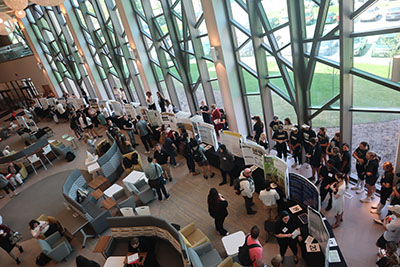Student Type
Graduate
College Affiliation
College of Science, Technology, and Health
Department
Health & Exercise Department
Submission Type
Poster
Abstract
Endurance running events like 100 miles distance races are becoming more popular. Humans are eager to explore their limits by challenging themselves to run 100 miles distance races. However, there are many research gaps still exist to fully understand the impact on the body that 100 miles endurance event has.
The aim of this study was to measure and analyze the impact of the 100 miles endurance race among recreational runners. Ten male recreational runners (age 36.6 ± 14.1) were screened before and after completing 100 miles distance running event in Missouri. Test screening included VO2 max, RMR, BIA, Ultrasound of the vastus lateralis muscle, and Muscular strength performance (countermovement jumps (CMJ), bell squats).
Overall, 100 miles distance running did not proof to have large impact on the body. The only significant changes were found in intracellular & extracellular body fluids, as well as, braking RDF (rate of force development), and force at peak braking force during CMJ testing.
Recommended Citation
Zavisiute, Karolina; Richmond, Scott; Kerksick, Chad; Sunderland, Kyle; and Mumford, Petey, "Physiological Measurements Pre/Post Ultra-Marathon Distance Race" (2023). 2023 Student Academic Showcase. 17.
https://digitalcommons.lindenwood.edu/src_2023/Posters/Session2/17
Included in
Physiological Measurements Pre/Post Ultra-Marathon Distance Race
Endurance running events like 100 miles distance races are becoming more popular. Humans are eager to explore their limits by challenging themselves to run 100 miles distance races. However, there are many research gaps still exist to fully understand the impact on the body that 100 miles endurance event has.
The aim of this study was to measure and analyze the impact of the 100 miles endurance race among recreational runners. Ten male recreational runners (age 36.6 ± 14.1) were screened before and after completing 100 miles distance running event in Missouri. Test screening included VO2 max, RMR, BIA, Ultrasound of the vastus lateralis muscle, and Muscular strength performance (countermovement jumps (CMJ), bell squats).
Overall, 100 miles distance running did not proof to have large impact on the body. The only significant changes were found in intracellular & extracellular body fluids, as well as, braking RDF (rate of force development), and force at peak braking force during CMJ testing.


